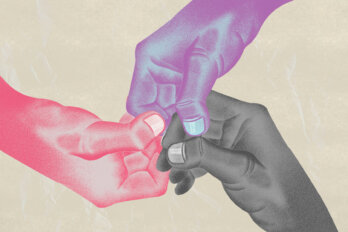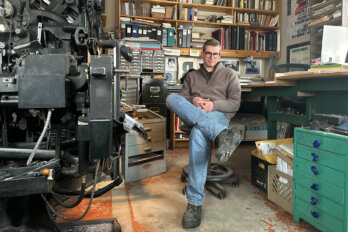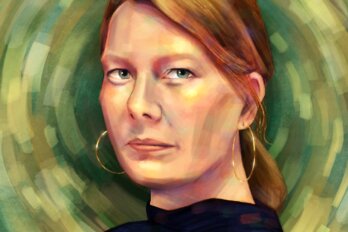I have spent most of my life making movies: documentaries, drama, television, IMAX. When I am not making movies, I am cooking or baking. The trouble with both filmmaking and cooking is that they are a lot of trouble. Both films and cakes can turn out brilliantly or just so-so. And, depending on the outcome of either, you may find all the trouble and expense was just not worth it. Even if you’re only making simple chocolate chip cookies, if those cookies do not taste, or look, as you imagined they would, it’s as if you shouldn’t have bothered in the first place. It’s similar to turning out a dull film—except that baking usually takes, at most, a day: the shopping, the preparing, the actual baking, the cleanup, and the serving of the results. A movie, on the other hand, can take anywhere from one to five years. First you need to raise dough (ha!), then there is the writing and researching, the planning, casting, shooting, editing, and, at last, the presenting of the film.
A cookbook recipe is not exactly like a script, but their purpose connects. For me, a recipe sparks fantasies of delighted guests responding to the charm and flavour of the cooked results. I envision it as a small dream sequence in which everything works out pretty well, including, say, the lighting of the alcohol poured over the duck or poached pears—a perfect plume of flame to light the occasion. A script is a challenge: you can’t really assemble the goods until you go out and see what you can get. Sometimes it feels a little like shopping in a store full of vegetables for ingredients to make an elaborate meat dish. You might even have to go out and shoot the game or catch the fish. The challenge is to make the documentary with what you can shoot—to conform the recipe to what you can find.
Yet in the making of the film, or the baking of the dish, one remains optimistic, albeit often with a soupçon of deep fear. With food, it’s the cookbook that gives us the confidence to go down the path—someone, somewhere has made this dish before, and we presume we simply have to follow the lead. After we do it once or twice we may even improvise; we may make the dish even better than the cookbook author deemed possible. A script may similarly serve to set a path, but I never love a movie script the way I love the movie itself. Scripts are intentionally lean. And once the movie is done, I will not make that same movie again, with more flavours. It’s unthinkable. Once it is done, it is done.
This is, perhaps, why I sometimes love cooking—and cookbooks—more than I love making movies. You might not guess it, but cooking allows for infinitely more possibilities of making magic, of creativity. For these reasons and more, I love cookbooks and always have. While they were out of my financial reach in my childhood, I got lucky in my late teens. My boyfriend’s mother worked on a hospital book drive where the cookbooks of the generous and the deceased ended up. She was a good friend to me, and managed to divert cookbooks my way whenever she could. I once made coquilles St. Jacques—scallops in cream sauce defined by piped delicate mashed potato around the edge of a proper seashell—with that same boyfriend when we were both seventeen. And it was in this fortuitous way that my cookbook collection began.
Since then, I have often been given beautiful recipe books. However, I rarely buy cookbooks for myself. I find I cannot buy a recipe book until I have confidence in it. That means I need to make some of the recipes first and I need to love them. (The exception has been cookbooks written by friends, which as it happens I did appreciate luckily—the books, the recipes, and especially the friends.) I very often go back to the tried and true, which in my case are recipes that I have fiddled with over the years: more of this, less of that. Deviating from the script in cooking can produce magic. What about a little caviar drizzled on top? Or some fresh-baked meringue broken up into the whipped cream? These adjustments can be transformative. Mix up some mission figs with olives and garlic? This creativity can make life worth living.
Treating a documentary film shoot with the same daring and optimism can sometimes yield a similar magic. Who could have predicted that when I indulged my crew’s longing for street-vendor ice cream on a road in Santa Monica while shooting Wisecracks, a film about female stand-up comedians, it would turn out that Whoopi Goldberg also needed an ice cream cone at that exact moment? And who would have guessed that after a brief conversation with her she would invite us, with our camera gear, to the set of Comic Relief? Or that, while filming my documentary on abortion, our crew would chance upon a health care worker showing the Akha hill tribe people of Thailand how to unroll a condom, demonstrating on the handle of a broomstick? Both encounters were gifts from the documentary gods. Like baking a layer of cheese atop a bowl of French onion soup: good without it, but superlative with it.
These years much of my kitchen space is taken up by cookbooks, some of them falling apart from overuse, some of them stained from various moments of cooking carelessness—and enthusiasm. I suspect you could put one or two of these books in a pot of simmering broth and make quite a hearty soup. Many of the books are souvenirs from my travels. On film shoots I often ended up in local kitchens, sometimes with people whose language was incomprehensible to me. Cooking was our shared language. And very often they proudly made a gift to me of a cookbook in their language, with recipes we made together underlined and annotated. (Later I would get translations.)
And yet, despite my long love of cookbooks—or perhaps because of it—when I received a copy of The Redpath Canadian Bake Book this year, I was a little taken aback. It had some of the features of the best of the newest, most popular books, including a solid hardcover and a substantial heft, weighing in at just over three and a half pounds. Yet, it also seemed like the corporate enterprise it is. Billed as the cookbook that “makes baking simple,” the book promises to be “a classic on bookshelves, providing truly delicious and timeless recipes for years to come.” Indeed, there are more than 200 recipes in the book, including those that are presumably meant to showcase the “distinct culinary traditions of Canada.” Potential bakers could, if they wanted, make everything from cookies and cakes to breads and custards—all while reading about how the company makes sugar, its “humble beginnings,” and its “sweet innovations.”
Flipping through the book, I thought, Gee, how daring of Redpath Sugar! After all, the company had decided to push its product in an era when sugar is so often synonymous with the words “poison,” “health risk,” “addictive”—even “demon.” In North America the annual revenue from the weight-loss industry is well over $20 billion, and much of it is centred on getting people to give up sweets. Meanwhile, Redpath, which began in 1854 as a sugar refining company in Montreal, has been providing Canadians with that essential cooking ingredient for more than 160 years. Today, the company’s headquarters—and main refinery—sits on Toronto’s waterfront, wafting the perfume of burnt marshmallow into the air.
The author of The Redpath Canadian Bake Book is never mentioned in the book itself. This intrigued me. A cookbook authored by “anonymous,” produced by a sugar refinery? Why be so coy, so cagey? I felt I needed to know who’d written it before I could trust the contents. And so I called Redpath to book a tour—or, at least, I tried to book a tour. Instead, Redpath agreed to guide me through the museum located inside the Toronto refinery: cute, but not terribly exciting. My Redpath host, a longtime Redpath employee named Nancy Gavin, was, however, a fount of knowledge. She also admitted under pressure that she was the author of the cookbook, before quickly adding that in an organization like Redpath, many people are involved in the decision-making.
Even so, I peppered her with questions about the recipe testing. I wanted to visit the test kitchens, which are referred to in a section of the cookbook called “The Baker’s Kitchen.” I love kitchens, and love to see how other people organize their equipment. I am a poor organizer: my own kitchen has almost everything exposed. Two dozen or so pots and pans, a mix of copper, cast iron, and modern miracle material. A lot of handmade pottery from travels; utensils made by traditional methods in Nepal and Bolivia; carefully honed knives from Kyoto, Japan. And too many cookbooks. I wondered what the test kitchen that produced such a weighty tome would look like; maybe I could learn something. I was sure it would be incredibly well-planned.
What I learned instead is that there are no test kitchens at Redpath, contrary to what the so-called author, writes: “In the Redpath test kitchen, you’ll always find the pantry items listed here.” My guide reported that in fact, all the recipes were tested in an outside facility. So my Redpath tour featured no test kitchen, no pantry items, no latest advances in helpful baking papers or pans. No there there. Gavin explained that they had also used an outside agency for the photos. Like most of the cookbook, the photos are . . . correct. They make the dishes feel like they are not tasty. Like they need more sugar. More cinnamon. More butter. I lay awake that night thinking about lost opportunities. I’d had high hopes for this new book, but I was not excited.
To be fair, the recipes in the The Redpath Canadian Bake Book seem good and reliable—you might say, like Redpath sugar itself. But I was never moved to rush to the kitchen and plunge in. Still, I felt obliged to test a recipe or two, and I chose a favourite sweet: cinnamon buns. I consider myself at least an aspiring master of the cinnamon bun, and I am admittedly (and, I would argue, rightfully) particular about the way they are made. I abhor the cream icing that ruins a good cinnamon bun, but the Redpath recipe includes it. Why would you add sickly sweet icing to a perfectly made cinnamon bun? Why do you need the extra sugar? It smothers the flavours of the bun’s bits of caramelization, the cinnamon’s magical aroma, the stickiness; it overwhelms the melted butter, the divinely curled and yeasty baked dough.
The majority of the recipes in Redpath’s baking book do leave it up to the individual cook to define his or her idea of perfection. Masterful simplicity is what makes baking, and cooking in general, compelling. You can play around with recipes, but first it’s important to know the essential, best-possible taste of the naked dish, unencumbered. On the other hand, I believe every cook needs some inspiration, some initial flicker of magic—whether it comes from the act of baking, or, ideally, from the cookbook authors themselves. As an anonymous enterprise, the Redpath cookbook ultimately offers little of either.
Instead, I would have much rather read about something personal, something real: why not, for instance, include a full section on Redpath founder John Redpath’s activities in the anti-slavery movement in the 19th century? It was a time of deep misery for humans working in the cane fields of Brazil and the Caribbean, under horrible conditions, and both places today remain a source for Redpath’s sugar.
What I’ve learned from making and baking is that you just have to keep going. Keep track of your efforts. Try to make the cake or cookie or roast or casserole better each time. And do the same in your work. In your movie. In your garden. I’ve gleaned that a cookbook is both like a script and not like a script. A cookbook is at best a learned guide. Like a script, it needs you to transform what’s on the page into something that will delight your taste buds, your mouth, your eyes, your brain. If you do that, and find the magic in it, you can have a happy life.





